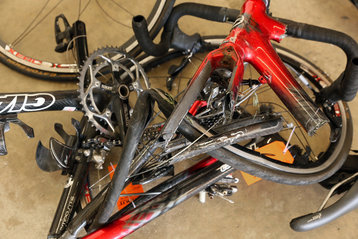 ~diagnosing, repairing, and replacing your bike after a collision. By Lance Hester Whenever we handle vehicle related injury claims, two claims typically exist – the personal injuries, and the property damage. In car accident cases, the property damage tends to get resolved without our participation (eg. Car is totaled, insurance pays claimant the market value for the car). The bodily injury side of the case, on the other hand, takes months, if not longer, requires lots of calculations and records reviews, and ultimately resolves after many sessions of negotiations or a trial or arbitration. You don’t have to look too far down the racks at the Lake Meridian Triathlon, the Black Diamond, or any of the Ironman events before your senses cause drooling at the sight of a Cervelo P5 with carbon fiber everything – wheels, bottle cages, handle bars – not to mention electronic gears, gps cycle computers, and power metered pedals. Something like that, my friends, is worth more than the car I show up in on race day. Sources For Your Expensive Mess So what’s a cyclist to do when the love of his Saturday morning training sessions is battered, or worse, by a negligent driver? Here’s a checklist for determining the future of your bike.
 Bike Diagnosis and Valuation: While insurance claims managers are becoming more familiar with bicycle claims, you may find yourself in the position of having to educate him or her as to the issues relevant to your loss. To fully make your case, you will be wise to do two things as comprehensively before making a demand: 1. Have your bike’s injuries diagnosed; 2. Assemble a report on valuation. Diagnosis: Some of this can be DIY. In obvious cases, make sure you have lots of photos of your bent or broken frame, damaged wheels, and scratches and scrapes. If you’ve got a carbon fiber bike, make sure to have lots of photos, but also check with an experienced shop to see if they are willing to inspect, photograph and document the bike’s injuries. You should also check with the manufacturer. Some manufacturers will be willing to analyze the problems as they determine whether the bike falls under a warranty. The manufacturer may take interest in examining how its product withstood (or not) the forces of impact during the collision. I have read an article by a colleague who suggests traditional medical imaging (CT scans) for determining continuing carbon fiber safety. Small cracks in a carbon fiber frame can mean the entire integrity of the bike is compromised and needs replacing. Valuation: Gather what you can. If you purchased your bike new, find the receipt. If it needs repair, have your experienced shop produce a repair estimate; if it needs replacing, see if they can document the current replacement cost as well as a possible comparison they may have taken in for a certain trade-in value. And again, find whatever comparables you can in the marketplace. And finally, don’t forget loss of use. This is most important for commuters. In the event of lost use of your bike, just as if it were a car, you may be entitled to a rental while the diagnosis, valuation, and replacement negotiations are pending. Figure out the per day amount and what duration is allowed, and see if you can’t get right back on the bike. This is all about the bike. Next time, we’ll talk about the injured human, and insurance sources for protecting cyclists and, Heaven forbid, those whom cyclists may accidentally injure during races or training. Lance Hester is one of five partners who are active cyclists, runners, and swimmers at the Hester Law Group, a firm that takes cases in Washington, Idaho, and beyond, and is a proud sponsor of Raise the Bar and the events it hosts.
0 Comments
Your comment will be posted after it is approved.
Leave a Reply. |
Raise the BarRace reports, upcoming events, news, and more, from RTB. Archives
September 2023
|

 RSS Feed
RSS Feed




